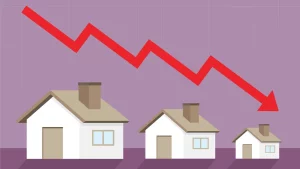Introduction
Hello, mystery lovers and problem solvers! I’m Fred, a seasoned blog writer with a passion for uncovering the hidden truths behind perplexing phenomena. In this article, I will delve into one of the most baffling mysteries of the year: why did mortgage demand fall sharply in the last week of 2023, despite a recent drop in interest rates?
As you may know, mortgage demand is a key indicator of the health and activity of the housing market, which in turn affects the overall economy. Mortgage demand reflects the number of people who are applying for mortgages to buy or refinance their homes. When mortgage demand is high, it means that more people are interested in purchasing or improving their properties, which boosts the construction, real estate, and financial sectors. When mortgage demand is low, it means that fewer people are willing or able to take on new debt, which signals a slowdown or a contraction in the housing market and the economy.
Mortgage demand is influenced by many factors, such as income, employment, consumer confidence, credit availability, and of course, interest rates. Interest rates are the cost of borrowing money, and they affect the affordability and attractiveness of mortgages. Generally speaking, when interest rates are low, mortgage demand is high, and vice versa.
However, in the last week of 2023, something strange happened. Interest rates fell to their lowest level since June 2023, but mortgage demand also dropped to its lowest level since December 1996, according to the Mortgage Bankers Association (MBA). This was a 9.4% decline from two weeks earlier, and a 18% decline from a year ago. This was a puzzling and perplexing phenomenon, as it defied the usual relationship between interest rates and mortgage demand. What could explain this anomaly? What were the factors that caused mortgage demand to fall so sharply in the last week of 2023? And what does this mean for the future of the housing market and the economy? These are the questions that I will try to answer in this article, using data, analysis, and insights from credible sources.
The Drop in Interest Rates
Before we explore the reasons behind the drop in mortgage demand, let us first examine the drop in interest rates. What caused interest rates to fall in the last week of 2023, and how significant was this decline?
The main driver of the drop in interest rates was the Federal Reserve’s announcement on December 15, 2023, that it was shifting its monetary policy stance from tightening to easing, in response to the worsening inflation and growth outlook. The Fed said that it would end its bond-buying program by March 2024, and that it expected to cut its benchmark rate three times in 2024, starting from June. This was a major change from its previous projection in September, when it expected to raise its rate twice in 2024.
The Fed’s announcement signaled that it was concerned about the impact of the Omicron variant of Covid-19, the supply chain disruptions, the labor market frictions, and the geopolitical tensions on the economy, and that it was ready to provide more stimulus to support the recovery. The market interpreted this as a dovish move, and reacted by lowering its expectations for future interest rates. This led to a decline in the yields of Treasury bonds, which are the benchmark for mortgage rates.
According to the MBA, the average contract interest rate for 30-year fixed-rate mortgages with conforming loan balances ($726,200 or less) decreased to 6.83% from 7.07%, with points increasing to 0.60 from 0.59 (including the origination fee) for loans with a 20% down payment, for the week ending December 29, 2023. This was the lowest level since June 2023, when the rate was 6.81%. However, this was still more than a full percentage point higher than a year ago, when the rate was 5.67%. This means that even though interest rates fell in the last week of 2023, they were still much higher than they were at the start of the Covid pandemic, when they reached record lows.
The Reasons Behind the Drop in Mortgage Demand
Now that we have established the cause and the magnitude of the drop in interest rates, let us turn our attention to the drop in mortgage demand. Why did mortgage demand fall so sharply in the last week of 2023, despite the lower interest rates? What were the factors that deterred or prevented people from applying for mortgages?
According to the MBA, there were several reasons behind the decline in mortgage demand, which affected both the purchase and the refinance segments of the market. These reasons include:
- The low housing inventory. One of the main challenges facing the housing market in 2023 was the lack of available homes for sale, especially in the affordable price range. According to the National Association of Realtors (NAR), the inventory of existing homes for sale in November 2023 was 1.05 million units, down 13.3% from a year ago, and equivalent to a 2.1-month supply at the current sales pace. This was the lowest level since the NAR began tracking the data in 1982. The low inventory meant that buyers had fewer choices, faced more competition, and had to pay higher prices, which reduced their demand for mortgages.
- The high home prices. The low inventory also contributed to the rapid appreciation of home prices in 2023, which made homeownership less affordable and accessible for many potential buyers. According to the NAR, the median existing-home price for all housing types in November 2023 was $353,900, up 13.9% from a year ago, and the 117th straight month of year-over-year gains. The high home prices also reduced the incentive for existing homeowners to sell their homes and move, which further constrained the supply of homes for sale, and the demand for purchase mortgages.
- The low consumer confidence. Another factor that dampened the demand for mortgages in the last week of 2023 was the low level of consumer confidence, which reflected the uncertainty and anxiety about the economic and health conditions. According to the Conference Board, the Consumer Confidence Index fell to 109.5 in December 2023, down from 111.9 in November, and the lowest level since February 2023. The decline was driven by the worsening expectations for income, business, and labor market conditions, as well as the rising concerns about the Omicron variant and its impact on the economy. The low consumer confidence made people more cautious and less willing to take on new debt, such as mortgages.
- The tight credit standards. Another obstacle that hindered the demand for mortgages in the last week of 2023 was the tight credit standards, which made it harder for borrowers to qualify for mortgages, especially those with lower credit scores, higher debt-to-income ratios, or smaller down payments. According to the MBA, the Mortgage Credit Availability Index, which measures the availability of mortgage credit, decreased by 0.4% to 119.8 in November 2023, indicating that lending standards tightened. The index was also 23.6% lower than a year ago, and 64.1% lower than its peak in June 2013. The tight credit standards reflected the lenders’ caution and risk aversion, as they faced higher costs, lower margins, and regulatory uncertainty in the mortgage market.
- The seasonal factors. The last factor that contributed to the drop in mortgage demand in the last week of 2023 was the seasonal factors, which typically reduce the activity and interest in the housing market during the winter months, especially around the holidays. According to the MBA, the seasonally adjusted index for the week ending December 29, 2023, was based on a 14-day adjustment period, instead of the usual 7-day period, to account for the Christmas holiday. This means that the index was compared with the average of the two weeks ending December 15, 2023, which may have distorted the magnitude of the decline. Moreover, the MBA noted that the unadjusted index for the week ending December 29, 2023, was 27% lower than the same week a year ago, which may have reflected the impact of the Covid-19 stimulus payments that boosted the mortgage demand in the last week of 2022.
The Implications for the Housing Market and the Economy
Having discussed the reasons behind the drop in mortgage demand in the last week of 2023, let us now consider the implications for the housing market and the economy. What does this drop mean for the future of the housing market and the economy? Is this a temporary blip or a sign of a deeper problem?
According to the MBA, the drop in mortgage demand in the last week of 2023 was not a cause for alarm, but rather a reflection of the mixed data and the changing expectations for the economy. The MBA said that it expected the mortgage demand to rebound in the coming weeks, as the lower interest rates and the easing of the Omicron variant would stimulate the demand for both purchase and refinance mortgages . The MBA also said that it expected the housing market to remain strong in 2024, supported by the robust demand, the limited supply, and the favorable demographics .
However, some experts and analysts were more cautious and pessimistic about the outlook for the housing market and the economy, citing the persistent challenges and risks that could undermine the recovery and the stability . These challenges and risks include:




